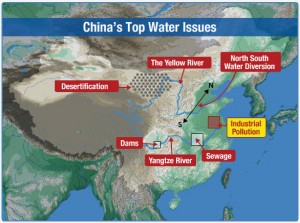US Water Issues Pale in Comparison to China’s
Posted on September 22nd, 2016 | No Comments »
Here in the US, we tend to equate drought with California. In recent years, California has made the news time and time again for increasingly strict rules on water usage. In 2016 the Northeast is also suffering our worst drought in the last 20 years. To most Americans, the idea of water rationing is something that is almost entirely foreign. Unfortunately, for hundreds of millions of Chinese, water rationing is a fact of life.
 With a US population of approximately 320 million people, America has total renewable water resources of 3,069 cubic kilometers. By contrast, China has a population of 1.37 billion people but only has total renewable water resources of 2,840 cubic kilometers. This means that the average Chinese has access to less than a quarter of the water resources of the average American. A full 60% of Chinas 661 cities face seasonal water shortages, while over 100 cities suffer severe water constraints. Starting in 2013, the Chinese central government began issuing water quotas to every single province in the Peoples Republic. Many experts predict that China faces a looming water crisis.
With a US population of approximately 320 million people, America has total renewable water resources of 3,069 cubic kilometers. By contrast, China has a population of 1.37 billion people but only has total renewable water resources of 2,840 cubic kilometers. This means that the average Chinese has access to less than a quarter of the water resources of the average American. A full 60% of Chinas 661 cities face seasonal water shortages, while over 100 cities suffer severe water constraints. Starting in 2013, the Chinese central government began issuing water quotas to every single province in the Peoples Republic. Many experts predict that China faces a looming water crisis.
Due to the urgent nature of water resource usage in China, both the Chinese government and the Chinese private sector are taking rapid action to address the issue. The Chinese government is currently constructing a multi-decade infrastructure mega-project called the South-North Water Transfer Project, which upon completion aims to divert 44.8 cubic kilometers of freshwater annually from water-rich Southern China to water-poor Northern China. Meanwhile, environmentally-conscious corporations such as Alibaba are now building data centers that are cooled by natural bodies of water.
Nevertheless, China still has a long way to go if it wants to use its limited water resources to maximum efficiency, and everyone there knows it. It is estimated that Chinese capital expenditure on industrial water and wastewater treatment will top $6.8 billion by 2020. Opportunities abound for American water companies with the right technology and the desire to enter the Chinese market. However, navigating through the complex landscape of the Chinese market can be very difficult, especially without a local Chinese partner.




